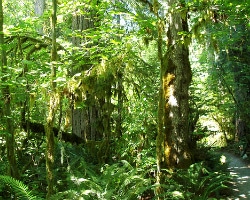
We are familiar with the concept that we can "vote with our dollars," also that we can "vote with our feet," but really, we can also "vote with our bodies." Access to green burial grounds and services have started to expand as more people look for alternatives to conventional death care and creative ways to protect natural areas from development. And by choosing a disposition option that protects land from development, we are in a sense voting with our bodies.
The latest green guardians to offer natural burial services is Herland Burial Forest, nestled on a mountain slope in the State of Washington. Their approach to stewardship is from the standpoint of being akin to the wildlife that inhabit this particular forest.
All living things affect their environment, always. Every action is in response to a shifting foundation. It is within this dynamic that creatures find ways to survive, and are selected for their fitness to the changing ecosystem.
As the woodland develops, it will become an increasingly attractive place for family and friends to visit. It is an essential leap that communities are going to have to make if they desire to understand how ecosystems operate.
Natural burial grounds are open to all. They are seldom linked to any one religion or belief, although individual graves can be consecrated as desired. They offer an environmentally friendly, cost effective, and permanent alternative to traditional funerals, cemeteries, and graveyards.
Herland Forest is a manifestation of these values, and a way for ecologically compassionate people to make a final contribution to the next generation of Earth stewards. To keep the rolling stone moving onward, we can use our bodies as a barrier to development, and also in support of ecological understanding of community and cultural evolution.
Although the burial forest is managed by a community collective, they believe that their values and world view are similar to those of the people who seek out natural burial options. The baby boom generation who came of age in the '60s and '70s are credited with attempting to redefine the American commercial-consumer values, and they grew up in an increasingly complex technological/marketing society—a culture that had, en masse, lost contact with the Earth as the foundation for human life. A relationship with death and dying is a big part of this. It is more and more apparent that, as William Ralph Inge said, "The whole of nature, as has been said, is a conjugation of the verb to eat, in the active and in the passive."
The giving life and death happens simultaneously. Death in the pathway to new life. All life building upon one another, creating more of a context for life. An ever-evolving spiral. Life and death all the time, the predator is always on the hunt. The raven is always looking for a meal. We must fill our bellies, and in turn fill the bellies of others, be it micro organisms, plants, insects, fungi, animals, whatever. All of nature is a graveyard.





